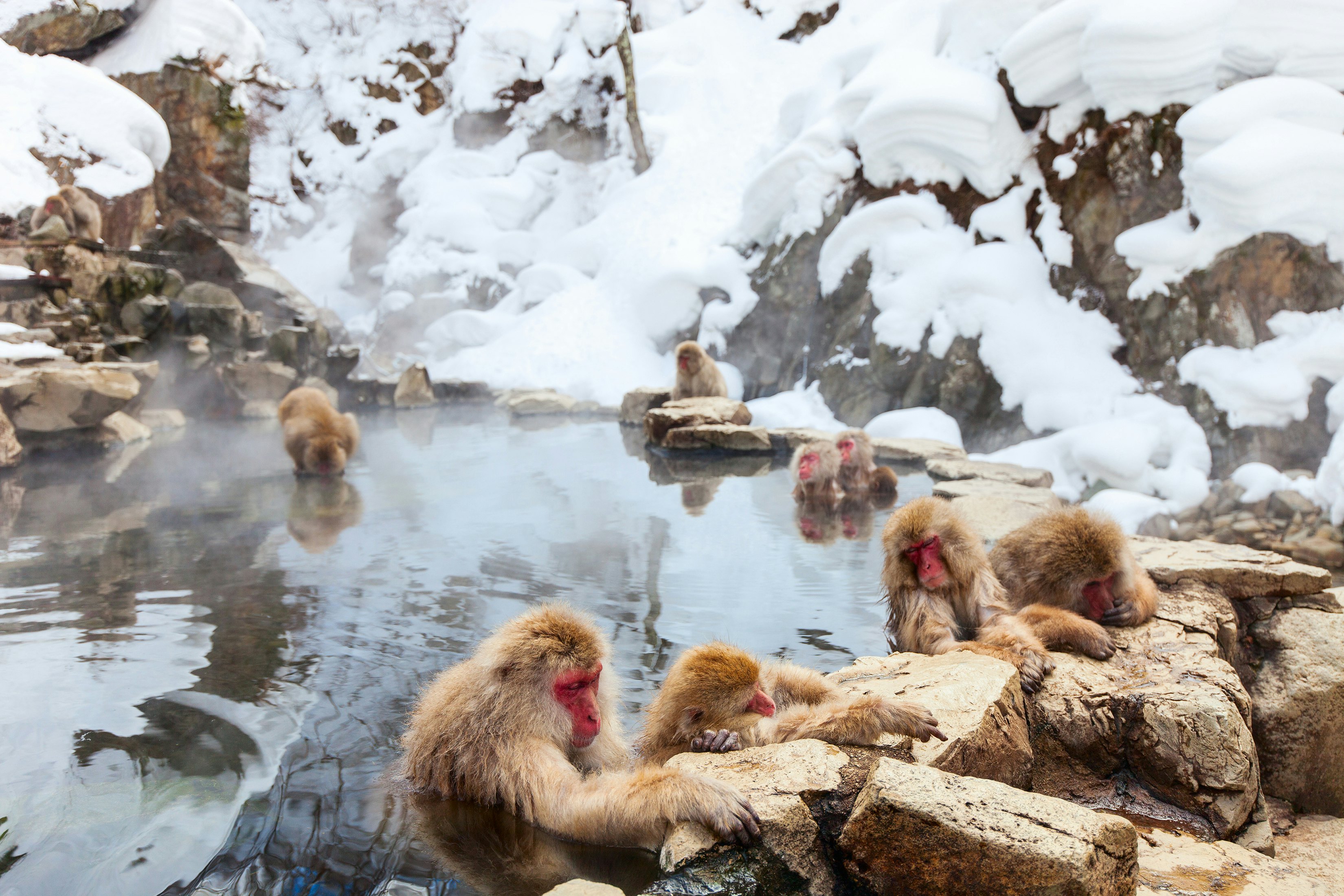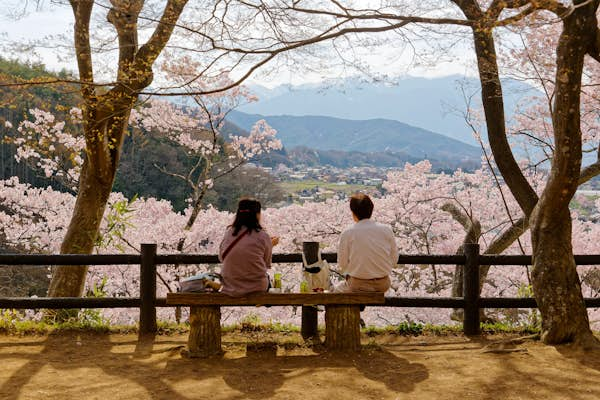There are 47 prefectures in Japan, but – in my humble opinion – Nagano is simply the best of the best. In fact, Japanese travelers agree: it ranked in the top 10 most attractive prefectures in 2024.
Nagano Prefecture is huge, encompassing the breathtaking Japanese Alps, ancient trading routes, picturesque lakes, multiple sake breweries, modern-day art, refreshing hot springs and more. In winter, it’s a snow sports paradise; in spring, traditional villages erupt in cherry blossoms; in summer, the mountains provide relief from the harsh heat; and in fall, the forested slopes erupt in a blaze of oranges and reds.
Advertisement
It’s impossible to experience everything Nagano Prefecture has to offer in just one trip or season, so here’s a first-timer’s guide to help you make the very best start.

When should I go to Nagano Prefecture?
Let your interests decide the best time to visit. If you’re looking to walk some of the old trade routes, spring and early summer offer some of the kindest annual temperatures, and you’ll get to admire a range of blooms, from cherry blossoms to wild flowers, depending on the timing and elevation. The Japanese Alps or the elegant mountain town of Karuizawa offer reprieve from the summer heat, although it’s best to avoid the mid-August Obon Holidays, particularly if you’re headed to Kamikochi, where private cars aren’t allowed and buses can get crowded. Fall brings a spectacular ocean of autumn foliage, just be aware of Kamikochi bus crowds (again!) and that the occasional typhoon in September and October might force you to postpone any hiking plans. Snow sports season typically starts from mid-December to late March, but several resorts with higher elevation slopes operate for longer.
How much time should I spend in Nagano Prefecture?
The sheer scale of Nagano Prefecture and array of stunning destinations means that you could easily while away two weeks! For first-time visitors, however, four to five days will give you a good sense of the area’s natural beauty and rich culture, especially if you plan to spend a day or two walking or hiking. That said, a weekend trip from Tokyo is totally possible – Matsumoto, Nagano City and several winter resorts are an easy hop from the capital.
Is it easy to get in and around Nagano Prefecture?
Nagano Prefecture is extremely accessible. Nagano City acts as the main transportation hub, and is just 80–100 minutes from Tokyo on the Hokuriku Shinkansen with multiple trains per hour. What’s more, the route is covered by the Japan Rail Pass and JR East Pass Nagano Niigata Area, which allow unlimited travel on JR train lines within a set timeframe.
Matsumoto is another good base for exploring the region and lies just 2.5 hours from Shinjuku Station on the JR Azusa limited express, with one or two trains an hour. Magome-juku – a popular starting point for exploring the Nakasendo Trail and Kiso Valley – is about 1.5 hours from Nagoya Station.
Once in Nagano Prefecture itself, you’ll need to rely on local trains and buses. Services might be infrequent, but are extremely reliable. Rechargeable IC cards cannot always be used to pay, so make sure to carry cash – both coins and ¥1000 bill denominations. Renting a car is also an option, but note that Kamikochi has a ban on private automobiles all year round.
Advertisement

Top things to do in Nagano Prefecture
Hike through the breathtaking beauty of Kamikochi
Known as the gateway to the Northern Alps, Kamikochi is a mountainous region that boasts the kind of scenery that makes you take a moment just to absorb its sheer magnificence. Rugged peaks, forested slopes, snowcapped mountains, and tranquil ponds that mirror matchstick trees and an azure blue sky – the natural offerings here are endless. Best of all, it’s a place that caters to all fitness levels. Beginners can enjoy flat strolls alongside the Azusa River whereas experienced hikers can traverse some of Japan’s most well-known peaks, staying at mountain huts along the way. The official Kamikochi website offers a helpful list of walks and treks ranked by difficulty.
Step back in time in the picturesque Kiso Valley
A world away from the hectic hubbub of Japan’s major cities, Tsumago-juku and Narai-juku in the Kiso Valley are frozen in time, connected via stone-lined paths, forested ways and countryside lanes. These villages lie along the Nakasendo Way, a key route connecting Edo (now Tokyo) and Kyoto in the Edo Period (1603–1868). The Tokugawa shogunate, which ruled Japan during this time, strictly controlled movement, meaning most people had to travel on foot. “Post towns” sprung up along the way to cater to travelers’ needs. Head to Magome (technically Gifu Prefecture) to begin a relatively gentle 8km (5-mile) walk that winds through forests, past rice fields and local residences to Tsumago, which is considered one of the best preserved post towns in the region. Staying at a minshuku (family-run budget accommodation) or ryokan (traditional Japanese inn) to experience local Japanese hospitality and cuisine is an absolute must.
Hit the slopes for snow sports
Home to the Japanese Alps, Nagano is a dream for skiers or snowboarders. One of the most popular destinations is Hakuba Valley, which boasts more than 200 runs across 11 resorts, and offers ample terrain for a range of levels from beginners to backcountry pros. Or stop for a few days at the charming Nozawa Onsen. As well as offering a good mix of terrain to suit all levels, the town itself is full of traditional buildings, narrow streets, and public bathhouses for a warming and relaxing soak after a hard day on the slopes.

Admire monkeys bathing in a hot spring in the snow
“The only place in the world where monkeys bathe in hot springs” proclaims the official website, and with a tagline like that, how can you resist?! The Japanese macaques of Jigokudani Yaen-koen are undoubtedly one of the most iconic images of Nagano. Although the hot spring park was officially established in 1964, the monkeys are entirely wild, freely coming to bathe and leaving as they like. “Jigokudani” literally means “Hell Valley” in reference to its dramatically steep cliffs and steaming pools. Situated at 850m (2789ft) above sea level, the area usually has snow cover from December through March, but January and February are the best times to enjoy the scene with a blanket of white. Note that due to its remote location, reaching the hot spring involves a short walk of 30–40 minutes from the bus stop and sturdy footwear is advised in winter.
My favorite thing to do in Nagano Prefecture
The one place I’ve found myself coming back to again and again is Matsumoto. I once even spent the New Year holidays there and ended up dancing in the street with locals at midnight. The next day, I took a morning run to a hillside park with stunning views of the snowcapped Alps and welcomed New Year’s Day feeling refreshed and at peace.
A compact, laid-back city, Matsumoto begs for you to take a stroll, hop between a coffee shop or two, and just soak up the atmosphere, while of course taking time to admire its striking black castle. First-time visitors should also stop by the Matsumoto City Museum of Art, which features works by the Matsumoto-born artist Yayoi Kusama of polka-dot fame, and foodies will enjoy a visit to Ishii Miso Brewery, where they can glimpse the miso-making process followed by a delicious miso-themed lunch.
How much money do I need for Nagano Prefecture?
While generally much cheaper than Tokyo, there are seasonal and regional price variations across Nagano. Expect to loosen your purse strings if you’re headed to the upscale Karuizawa or to any of the winter sports resorts, and it’s best to book accommodations far in advance for the ski season. As with most countryside destinations in Japan, always carry cash.
Here are a few prices to help you get budgeting for your visit:
-
Basic hotel room: ¥7000 (US$50)
-
Basic ryokan: ¥10,000 (US$71)
-
Upmarket ryokan (with breakfast and dinner included): ¥40,000 (US$285)
-
Basic hotel room in Hakuba ski resort for a room for two people (single occupants often still have to pay the basic twin or double room price): ¥35,000 (US$250)
-
Hakuba Valley one day lift pass: ¥9700 (US$69)
-
Matsumoto to Kamikochi bus (must be reserved in advance): ¥4450 one way (US$32)
-
Casual dinner at an izakaya (Japanese pub-eatery): ¥3000–5000 (US$21–36)
-
Upmarket dinner: ¥10,000–20,000 (US$71–142)
-
Coffee: ¥450–800 (US$3.20–5.70)
What are the best things to eat in Nagano?
Nagano is known for its incredible diversity of ingredients and cuisine. First up, all visitors should start with oyaki, a kind of dumpling made from wheat or fermented buckwheat flour. Fillings can be savory or sweet, and my absolute favorite is another local delicacy, pickled mustard greens, sometimes with some added chili for an extra kick. The region’s soba (buckwheat noodles) are well renowned and particularly delicious with wild mountain vegetable tempura in spring or mushroom tempura in the fall.
Nagano is a landlocked prefecture, but there’s excellent fish sourced from rivers, and a local delicacy is the “Shinshu Salmon,” a crossbreed of female rainbow trout and male brown trout. Shinshu wagyū (Japanese beef) is valued for its beautiful fat marbling and soft texture, and Nagano produces almost half of all miso consumed in Japan. For the more adventurous, some traditional taverns might serve hachinoko (wasp or bee larvae), often simmered in soy sauce and mirin (sweet cooking sake). Fear not – they taste just like mildly sweet shrimp or clam, and make an excellent topping for rice.
Lastly, Nagano has some of the best sake in the whole of Japan. For a fun afternoon, head to Suwa and buy a “Gokuraku Set,” which will give you a glass and stamp card, and lets you sample sake at five breweries, all within walking distance!

Does everything close in winter months?
As a mountainous region, Nagano Prefecture receives heavy snowfall. Be aware that many attractions and roads will be closed during the winter months. The hiking season at Kamikochi National Park runs from late April to November. If visiting Jigokudani Monkey Park, the nearest parking lot is closed during winter, so it can only be accessed by the public bus and a short walk. If renting a car in winter, make sure you have snow tires to tackle the roads.
What local festivals are there?
People in Nagano know how to have fun, so be sure to search whether there are any local festivals, or matsuri, before you set off on your travels. Lake Suwa Fireworks Display in August is one of the most spectacular in the country, and there’s a second event in September to choose the new fireworks for the following year. Matsumoto Grand Taiko Festival takes place on the last weekend of July every year, with performances by drumming groups from all over Japan. For a smaller yet wackier event, there’s the Frog Festival held on Nawate St every two years in June, with lots of frog cosplay, snacks and memorabilia. For a truly spectacular and very rare experience, though, you should come back to Nagano during the once-in-seven-years dramatic and dangerous Onbashira Festival, where giant tree trunks are cut down, rolled down the hill while being ridden by participants, dragged across a river and taken to Suwa Taisha Shrine to replace the sacred wooden pillars.

